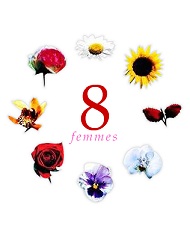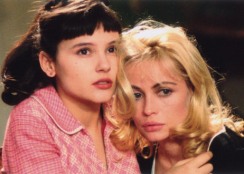|
8 Women
aka 8 Femmes
|
| |
 |
France, 2002. Rated R. 103 minutes.
Cast:
Catherine Deneuve, Isabelle Huppert, Virginie Ledoyen, Fanny Ardant, Danielle
Darrieux, Emmanuelle Béart, Firmine Richard, Ludivine Sagnier
Writers: François Ozon, Marina De Van (screenplay collaborator),
freely adapted from the play by Robert Thomas
Music: Krishna Lévy (score)
Cinematographer: Jeanne Lapoirie
Producers: Olivier Delbosc, Marc Missonnier
Director: François Ozon
LINKS
|
 hen
is a movie less than the sum of its parts? When the parts make no sense together,
and when the stated purpose of the film, to celebrate women, is undercut by
the content. 8 Women is a pastiche of an Agatha Christie murder mystery,
classic Hollywood musicals such as the films of Vincente Minnelli, and trashy
modern camp like Wild Things. Just when one element of the film becomes
absorbing (the intriguing whodunit, the appealing musical numbers, or perhaps
even the catty lesbianism), the film abruptly shifts to a different mode, and
you mentally veer back and forth to keep up. A loved one has been murdered!
How about a song and dance? 8 Women is definitely funny, sometimes in
the way that The Rocky Horror Picture Show is funny. You're never quite
sure whether you're laughing at what writer/director François Ozon intended.
hen
is a movie less than the sum of its parts? When the parts make no sense together,
and when the stated purpose of the film, to celebrate women, is undercut by
the content. 8 Women is a pastiche of an Agatha Christie murder mystery,
classic Hollywood musicals such as the films of Vincente Minnelli, and trashy
modern camp like Wild Things. Just when one element of the film becomes
absorbing (the intriguing whodunit, the appealing musical numbers, or perhaps
even the catty lesbianism), the film abruptly shifts to a different mode, and
you mentally veer back and forth to keep up. A loved one has been murdered!
How about a song and dance? 8 Women is definitely funny, sometimes in
the way that The Rocky Horror Picture Show is funny. You're never quite
sure whether you're laughing at what writer/director François Ozon intended.
Let's back up a bit. Based on Charlotte Rampling's outstanding performance
in the chilly Under the Sand, Ozon has built a reputation as a women's
director, one who brings out their best. This reputation has allowed him to
reel in a dazzling cast of France's biggest female stars: Catherine Deneuve
(Belle du Jour), Isabelle Huppert (The Piano Teacher), Virginie
Ledoyen (The Beach), Fanny Ardant (Ridicule), Danielle Darrieux
(The Earrings of Madame de…), Emmanuelle Béart (Mission: Impossible),
Firmine Richard (Romauld et Juliette), and Ludivine Sagnier (Ozon's Water
Drops on Burning Rocks).
The intent was to craft an comedic all-female murder mystery with a 1950s look
and feel. Ozon went so far as to recreate the vibrant look of Technicolor and
to use an obviously artificial exterior backdrop, a painted canvas with fake
snow. The unrealistically glamorous costumes also hark back to classic films.
Ardant's outfit (in which she is supposed to have hiked through the snow) echoes
Ava Gardner in The Barefoot Contessa;  Deneuve's
appearance is inspired by Lana Turner; Ledoyen looks like Audrey Hepburn, and
so on. Each character is color coded, and each sings a classic French song that
expresses her personality and desires. The choreography of Sébastien Charles,
who used Gentlemen Prefer Blondes and the cabaret as two of his reference
points, is expressively simple.
Deneuve's
appearance is inspired by Lana Turner; Ledoyen looks like Audrey Hepburn, and
so on. Each character is color coded, and each sings a classic French song that
expresses her personality and desires. The choreography of Sébastien Charles,
who used Gentlemen Prefer Blondes and the cabaret as two of his reference
points, is expressively simple.
Getting carried away by the references to the past and the creative vision
conceals an underlying reality, however. Ozon does not love women. He has little
use for them, and may even hate them. Strip away the talk about classic cinema
and the incredible cast, and look at the characters portrayed by his
wonderful female actors. None of them is the slightest bit believable. All are
cold and remote, and the excessively stagy style of the film prevents any of
them from connecting with the audience either through humor or emotion. They
are all caricatures, heartless schemers and betrayers scarcely humanized by
the emotions of their songs. Conflicts and motivations are equally broad. This
might be fine in something like Wild Things, where the men are no better
and the movie does not pretend to be anything other than what it is. It's not
acceptable in a film with high-minded pretensions.
In their eagerness to work with Ozon and perhaps garner the same accolades
as Rampling, the greatest actresses in France are complicit in some pretty misogynist
material. Were any woman recognizable as a real human being, the fact that all
are cruel and unsympathetic might not matter. You might care about the outcome,
and would not be tempted to jump to general conclusions about the writer/director.
However, when all eight are exaggerated cut-outs, Ozon's attitude is inescapable.
He finds women aesthetically pleasing, but has no desire to get close. The least
dislikable of the eight, Catherine (Sagnier)--the tomboyish youngster with short-cropped
hair and the only one to wear pants--is also the most masculine.
The premise of the story is that these eight women, six of them related and
two comprising the household staff, have gathered for the holidays only to discover
the family patriarch knifed in the back--a metaphorically appropriate way for
him to go. Marooned in the manor by a snowstorm, they cast their suspicions
on one another, and their ad hoc investigations reveal ugly secrets.
Unavoidably, you begin to sympathize for the henpecked, cruelly used murder
victim--even though the henpecked, cruelly used murder victim is… Well, let's
not give anything away. Let's just say that he's no more a model father or husband
than the women are model mothers, wives, sisters, daughters, or employees. Yet
Ozon takes his side. Ugh.
Review
© September 2002 by AboutFilm.Com and the author.
Images © 2002 Focus Features. All Rights Reserved.

 Deneuve's
appearance is inspired by Lana Turner; Ledoyen looks like Audrey Hepburn, and
so on. Each character is color coded, and each sings a classic French song that
expresses her personality and desires. The choreography of Sébastien Charles,
who used Gentlemen Prefer Blondes and the cabaret as two of his reference
points, is expressively simple.
Deneuve's
appearance is inspired by Lana Turner; Ledoyen looks like Audrey Hepburn, and
so on. Each character is color coded, and each sings a classic French song that
expresses her personality and desires. The choreography of Sébastien Charles,
who used Gentlemen Prefer Blondes and the cabaret as two of his reference
points, is expressively simple.
